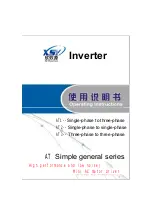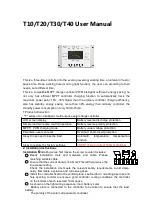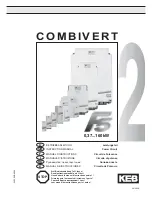
©
2020 Sensata Technologies
Page 11
Installation
2.3 Wiring the Inverter – General Requirements
This section describes the requirements and recommendations for wiring the MSH3012RV inverter/
charger. Before wiring the MSH3012RV inverter/charger, carefully read all instructions.
Wiring should meet all local codes and standards and be performed by qualifi ed personnel
such as a licensed electrician.
The NEC (National Electric Code, ANSI/NFPA 70) for the United States and the CEC (Canadian
Electrical Code) for Canada provide the standards for safely wiring residential and commercial
installations. The NEC/CEC lists the requirements for wire sizes, overcurrent protection, and
installation methods.
Inverter/charger systems involve power from multiple sources (inverter, generator, shorepower,
batteries, solar arrays, etc.,) which make the wiring more hazardous and challenging.
The input and output AC and DC circuits are isolated from the inverter chassis. The inverter system
grounding is the responsibility of the installer in accordance with the NEC/CEC.
WARNING
: Ensure all sources of DC power (i.e., batteries, solar, wind, or hydro) and
AC power (shorepower or AC generator) are de-energized (i.e., breakers opened, fuses
removed) before proceeding—to prevent accidental shock.
2.3.1
Protecting Wire – Conduit Box
The AC and DC wires to and from the inverter must be protected as required by code. This can
be done by using jacketed wires or by feeding the wires through a conduit box. Magnum offers
DC conduit boxes (ME-CB or MPX-CB) that allow both the AC and DC conduit to be connected to
the inverter.
Info:
The strain reliefs can be removed and replaced with 3/4” grommets if you are using
either the ME-CB or MPX-CB conduit box and the AC wires are individual conductors
(i.e., not jacketed).
2.3.2 Wiring
Requirements
• All conductors that are at risk for physical damage must be protected by tape or placed
in a raceway.
• Always check for existing electrical, plumbing, or other areas of potential damage prior to
making cuts in structural surfaces or walls.
• Do not mix AC and DC wiring in the same panel unless speci
fi
cally approved/designed for
both AC and DC wiring. Where DC wiring must cross AC or vice-versa, try to make the
wires at the crossing point perpendicular (90 degrees) to one another.
• Both AC and DC overcurrent protection must be provided as part of the installation.
• The inverter requires a reliable negative and ground return path directly to the battery.
• Use only copper wires with a minimum temperature rating of 167°F (75°C).
2.3.3 Wire
Routing
Before connecting any wires, determine all wire routes to and from the inverter. Typical routing
scenarios are:
• AC input wiring from the main AC panel to the inverter.
• AC input wiring from a generator (optional) to the inverter.
• DC input wiring from the batteries to the inverter.
• AC output wiring from the inverter to the AC sub-panel or to dedicated circuits.
• Battery Temperature Sensor cable from the inverter to the batteries.
• Remote control cable (optional) to the inverter.
• Ground wiring to and from the inverter.
2.3.4 Torque
Requirements
Torque all AC wiring connections to 16 in lbf (1.8 N-m). Torque DC cable connections from 10
to 12 ft lbf (13.6 to 16.3 N-m).
















































